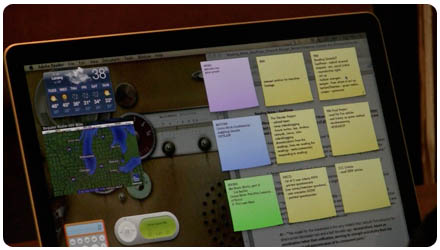Alternative (part 2/3): Compartmentalizing as Emerging Practice
<< Kathryn is a graduate student in philosophy who agreed to let me observe her writing during a particularly crucial moment. She had a long research paper due at midnight on the night that I observed her. With this in mind, she had assembled multiple materials in order to complete the task. Something a simple as finishing a final seminar paper required that she work with materials distributed across media, space, and time. Because so many materials were required, some sources she needed to reference were digital, while others were printed out on copy paper that was relatively easy to cart around, and still others were in books (not so easy to carry when she needed twenty of them). When negotiating sources for her seminar paper, it was already clear that she would need to move across different kinds of materials, working with a level of attention that allowed her sometimes to focus in on a particular text for a long time but also to move quickly among and between them, synthesizing and dialoguing multiple scholarly voices.
Was Kathryn Distracted?
Kathryn’s seminar paper was not written within a vacuum. While the individual task I observed already required her to shift attention across a number of media, genres, and arguments, she also wrote within the context of the other things that mattered in her life. When this larger context for her school writing is considered, it is no wonder that Kathryn frequently turned to other media and texts during her writing. Thus, the number of materials important to any given writing moment multiplied. Dealing with this proliferation of texts required Kathryn to attend to many kinds of writing over the course of completing the seminar paper. If she did not check her SMS text messages, her mom would think she had gone into hiding. If she didn’t keep an eye on her Facebook account, her friends wondered if she had survived finals week.
How Did She Deal With this Situation?
With this background in place, a practice central to how Kathryn and other students negotiated complex literacy environments involved enacting techniques of separation, which they described as necessary to structuring and negotiating among literacy demands placed on them. The blurring of domains and boundaries that happened when students were writing led them to create structures to separate the jumble into separate, accomplishable tasks and “information spaces,” to borrow the language of Johndan Johnson-Eilola who associates a similar process with symbolic-analytic work (71). Describing this practice, Kathryn said, “I need to separate things in some crazy way that makes sense for my brain.”
 She enacted compartmentalization both as a technique for
managing source material for her essay, as well as for making decisions
about when to attend to the social relationships that always seemed to
blur themselves into writing work time. For example, Kathryn focused on
the role annotation played for separating out text that mattered for her
argument. Pointing to a annotated source article she had brought into
the coffeehouse in order to write her paper, she said, “I like to be
able to see right at this part on this article, this is what I thought
was really important.” In writing her paper that night, Kathryn often
moved seamlessly across multiple previously annotated print copies of
scholarship. However, this movement was not a result of her distraction,
but rather of the previous work she had done to compartmentalize or
separate out parts of the scholarship that mattered for the given task.
In a similar way, she created structures for negotiating her social
life, deciding how long she would focus on the seminar paper before
checking Facebook or her phone. She did—often—move across multiple
technologies. However, to call her distracted is to miss much of the
planning and awareness she put into helping herself negotiate a
difficult academic task, while maintaining meaningful relationships. The
compartmentalizing that allowed students to subsequently move quickly
among tasks varied widely, from how participants organized materials to
how they made decisions about when to engage and when to ignore the
dings on their cell phones or messages coming into their inboxes. >>
She enacted compartmentalization both as a technique for
managing source material for her essay, as well as for making decisions
about when to attend to the social relationships that always seemed to
blur themselves into writing work time. For example, Kathryn focused on
the role annotation played for separating out text that mattered for her
argument. Pointing to a annotated source article she had brought into
the coffeehouse in order to write her paper, she said, “I like to be
able to see right at this part on this article, this is what I thought
was really important.” In writing her paper that night, Kathryn often
moved seamlessly across multiple previously annotated print copies of
scholarship. However, this movement was not a result of her distraction,
but rather of the previous work she had done to compartmentalize or
separate out parts of the scholarship that mattered for the given task.
In a similar way, she created structures for negotiating her social
life, deciding how long she would focus on the seminar paper before
checking Facebook or her phone. She did—often—move across multiple
technologies. However, to call her distracted is to miss much of the
planning and awareness she put into helping herself negotiate a
difficult academic task, while maintaining meaningful relationships. The
compartmentalizing that allowed students to subsequently move quickly
among tasks varied widely, from how participants organized materials to
how they made decisions about when to engage and when to ignore the
dings on their cell phones or messages coming into their inboxes. >>